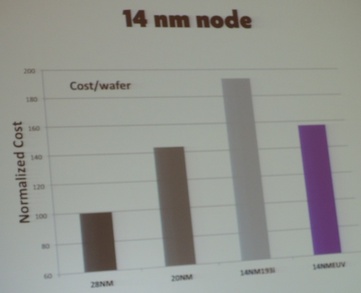Imec's Luc van den Hove vs. Intel's Mark Bohr

So who is right between those two giants?
Could it be that both of them are?
In a recent blog titled "Is the Cost Reduction Associated with Scaling Over?" we presented charts clearly supporting Luc van den Hove, IMEC's CEO, position. The following slide from an IBM presentation includes an NVidia chart (which we also discussed in another blog, Is NVIDIA in a Panic? If so, what about AMD? Other fabless companies? ).
GlobalFoundries, in its recent 14nm announcement, disclosed that the back-end will be unchanged from 20nm. This suggests a similar die size and respective increase in per-transistor cost. Further, ST Micro in the Fully Depleted Transistors Technology Symposium yesterday (Dec. 11) also acknowledged that their 14nm node will have a 20nm node metal pitch and, just like GlobalFoundries, a similar die size and increase in per-transistor cost.
In other words, it seems that the Luc van den Hove keynote is in-line with the cost road map of the non-Intel foundries!
Intel might indeed be different, yet something did cause Intel to take what seems like an extreme measure, when it put $4.1B in ASML just recently.
If, however, Mark Bohr has not been misled by the Intel accounting department, and the Intel process is still providing a nice cost reduction at every node of scaling, then clearly Intel has a true competitive edge relative to all other foundries. I have no doubts that Intel has filed enough patents to protect its unique process advantage, but then I wonder why did Mark say: "However...we don't intend to be in the general-purpose foundry busines ... [and] I don't think the [foundry] volumes ever will be huge [for Intel]."
If Mark Bohr is right, with such a competitive edge Intel should aggressively expand its foundry business, which would achieve both a great profit margin and rapid business growth. Now that Intel is looking for a new CEO its Board should consider it as a major criterion for who should lead Intel into the future.
P.S.
Clearly, dimensional scaling (and its cost reducing benefits) is not what it used to be, and the market appetite for cheaper-faster-better consumer-oriented products grows stronger. Both Intel and non-Intel fabs should start development of monolithic 3D technology. ;-)











 RSS Feed
RSS Feed